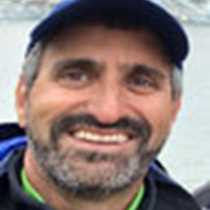Bayeux and Honfleur, Normandy, France
Gannets and skuas soared around the Endeavour as we sailed in to the Norman Coast and France. Here over a thousand years ago north men or Norse men settled, essentially becoming Frenchified and christianized Vikings. From these shores in Viking long ships with right-hand ‘steerboards’ (derivative of today’s directional terminology ‘starboard’), an army of determined men led by William the Bastard (soon to be renamed Conqueror) crossed the English Channel to pursue claim to the English Crown.
This is the story from one of history’s most familiar dates – 1066, when William defeated Harold at the Battle of Hastings. The tale was retold to us today from down the ages by our viewing of the world famous Bayeux Tapestry, an unsurpassed accomplishment of art and history. It is a remarkable embroidered-on-linen picture-chronicle nearly a millennium old proclaiming a campaign and victory, in the tradition of Assyrian reliefs and Roman columns. Besides displaying the chronological history of claim to the throne, including promises, deceits, the launching of ships, provisioning, omens (Halley’s comet) and gruesome battle details, the colorful stitchery is one of the best surviving documents of life in medieval times.
Other Endeavour guests visited the picturesque surviving medieval waterfront hamlet of Honfleur. A 16th century wooden church still stands, as does its self-standing clock tower once painted by Monet. This original pre-Impressionist work and canvases by Monet’s mentor Eugene Boudin hang in a local art museum. While the clouds, light and sky of the Norman coast we viewed today have been inspiration to this school of art, it has been suggested that Impressionism derived from attempting to paint rippling reflections on water; Honfleur sits at the mouth of the Seine, leading to the cultural center of Paris.
From the artwork of history of the Bayeux Tapestry to the history of art of Honfleur, we explored Normandy and added to the cultural tapestry we are weaving on this European Odyssey along the Atlantic coast.
Gannets and skuas soared around the Endeavour as we sailed in to the Norman Coast and France. Here over a thousand years ago north men or Norse men settled, essentially becoming Frenchified and christianized Vikings. From these shores in Viking long ships with right-hand ‘steerboards’ (derivative of today’s directional terminology ‘starboard’), an army of determined men led by William the Bastard (soon to be renamed Conqueror) crossed the English Channel to pursue claim to the English Crown.
This is the story from one of history’s most familiar dates – 1066, when William defeated Harold at the Battle of Hastings. The tale was retold to us today from down the ages by our viewing of the world famous Bayeux Tapestry, an unsurpassed accomplishment of art and history. It is a remarkable embroidered-on-linen picture-chronicle nearly a millennium old proclaiming a campaign and victory, in the tradition of Assyrian reliefs and Roman columns. Besides displaying the chronological history of claim to the throne, including promises, deceits, the launching of ships, provisioning, omens (Halley’s comet) and gruesome battle details, the colorful stitchery is one of the best surviving documents of life in medieval times.
Other Endeavour guests visited the picturesque surviving medieval waterfront hamlet of Honfleur. A 16th century wooden church still stands, as does its self-standing clock tower once painted by Monet. This original pre-Impressionist work and canvases by Monet’s mentor Eugene Boudin hang in a local art museum. While the clouds, light and sky of the Norman coast we viewed today have been inspiration to this school of art, it has been suggested that Impressionism derived from attempting to paint rippling reflections on water; Honfleur sits at the mouth of the Seine, leading to the cultural center of Paris.
From the artwork of history of the Bayeux Tapestry to the history of art of Honfleur, we explored Normandy and added to the cultural tapestry we are weaving on this European Odyssey along the Atlantic coast.




